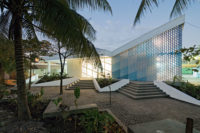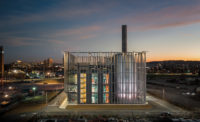“This project started with a disaster,” says Beat Huesler, head of Oppenheim Architecture’s Swiss office, about the boulder-like 20,000-square-foot water-treatment plant his firm recently completed in Muttenz, a municipality bordering Basel on the River Rhine. He’s referring to the 1986 Sandoz agrochemical fire, which caused tons of pollutants to enter the river—the principal source of drinking water for half a million people. The political fallout eventually resulted in Muttenz’s separating its water system from Basel’s and building its own filtration plant on a protected-forest site. Under the area’s strict environmental and building standards, typical industrial materials that might contaminate the stored water are prohibited. Oppenheim was hired to design an external envelope that would not only conform to code, but also blend in with the natural surroundings.
According to principal Chad Oppenheim, who founded the firm in Miami 20 years ago, the hardest part of the project was “creating the most economical building possible, because we were going to be under tremendous scrutiny where costs were concerned.” Opposition parties were contesting the expense of pulling out of the Basel system, and political pressure to remain within the $7 million construction budget was intense. Searching for a meaningful form, the architects decided to express the idea of economy by shrink-wrapping the plant in a concrete envelope that closely follows the contours of the equipment inside. They then covered it with a layer of semi-porous shotcrete, colored a rusty brown by the addition of clay and soil, so as to create “an organic object that begins to disappear into nature and doesn’t require repainting or refinishing. We wanted it to be beautiful in its decay,” explains Oppenheim. To perfect the naturalistic illusion, trees have been planted right up to the building’s perimeter and, once mature, will all but hide it from the forest approach.
A visitors’ center, placed to one end of the plant, afforded the team a little more architectural latitude. “Visitors are taken on a procession,” says Oppenheim, “a very purifying decompression in this industrial area. You’re near the highway, there are a lot of man-made structures, and then you enter this kind of sacred forest and meander past the water channels and the ground-filtration pools. Slowly, the building begins to emerge through the trees, and you’re not sure—is it part of nature or is it man-made? Then you enter a sort of cave, a very mystical experience, stepping over water, which reflects indirect light from above. We find that water is a very poetic medium to work with.” The facility is also, as he points out, a timely reminder of the element’s preciousness.










